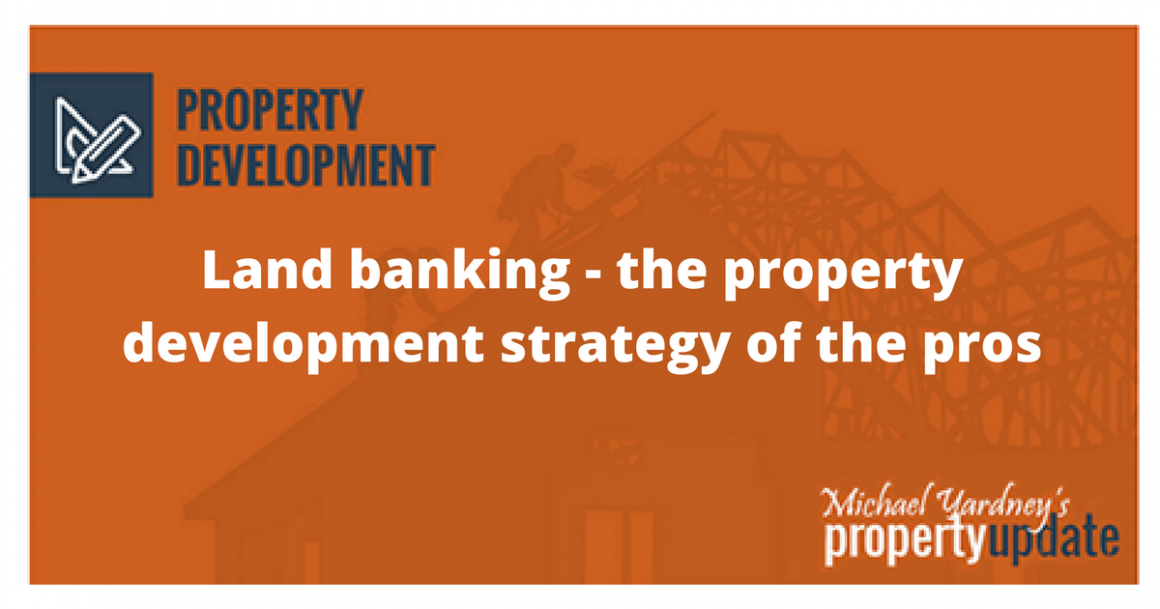How many times have you driven past a property and said to yourself, “If only I had bought that property when it was for sale five years ago? ”
”
Who wouldn’t have bought more properties 10 years ago if they knew they would have doubled in value, like many well located real estate has done over the last decade?
Fast forward five years from now – would you like to own a property development site that cost you much less than its current price?
Well maybe you should consider Land Banking – a strategy used by many professional property developers.
How Does Land Banking Work?
Land Banking is simply the process of securing future property development sites today, at the current price. 
Many large property development companies buy Greenfield sites, farms or large tracts of land and put them in their “land bank” to ensure they have a sufficient stock of land for future property developments.
Over time they rezone the land, put in the necessary roads and infrastructure, undertake a subdivision and on-sell the individual lots.
While holding a bank or stockpile of land has helped many developers make big profits in a rising market, it has also been the downfall of a number prominent developers when real estate values slumped, or rising interest rates blew out holding costs.
Land banking is a great strategy for smaller property developers too.
It’s an approach I’ve used successfully for the last few decades because I’ve learned to keep my holding costs to a minimum so they don’t break the bank.
You see…I don’t buy vacant blocks of land.
I buy old houses close to their “use by date” on well located blocks of land, with property development potential in top suburbs.
While the rent I receive partially offsets my holding costs, I add value to my site by obtaining property development approval (D.A) and then over time, proceeding with the property development.
Why is Land Banking a good investment strategy?
Many investors have made small fortunes by land banking because they are able to use a number of different property wealth accelerators that, when combined, generate substantial profits:
1. Land appreciates – we all know that it’s the land component of your property investment that appreciates, so buying a property close to its land value can be a smart strategy. 
2. Adding Value – by obtaining property development approvals you can add substantial value to a site.
Once you obtain a development approval for subdivision or for multiple dwellings, apartments or townhouses, you’ve taken out one element of the property development risk – the council approval process.
This makes your site more attractive to developers who may be prepared to pay a premium for it and it gives you the option of selling for a profit, or refinancing and continuing with the property development process.
3. Riding the property cycle – I like securing potential property development sites in a “soft” market.
At these times, completing a project may not be particularly lucrative, so I can buy these sites at a good price. 
As the market moves on, and it always does, the combination of a stronger market and owning a block of land with a D.A. in a prime position allows me to complete my project and make a substantial profit.
This strategy works particularly well in the inner and middle ring suburbs of our capital cities, where there is no vacant land for future development, but there is an increasing demand for new medium density developments from a whole new demographic of smaller households.
This includes Gen Y’s starting out in apartments, to DINKS (dual income no kids households); MINGLES (Middle Aged Singles) and Baby Boomers who are downsizing.
The combination of the current flat property market, a limited supply of potential property development sites and the future demand for more medium density housing make a perfect recipe for successful land banking.
What are the risks?
Each year I explain Land Banking plus a host of other property development and renovation strategies at my annual Property Renovations & Development Workshop but in short here are some cautions…
Whilst this strategy offers significant rewards, there are a host of traps for the unwary.
The biggest one is in relation to what type of project (if any) can fit on the property?
There are some properties, in fact many properties, that even if in the right location, don’t make good development sites.
At Metropole, we have a detailed checklist to assess properties for development potential.
Once we understand the local council’s requirements, some of the things we look for when we assess a site’s suitability for property development include:-
1. Size and dimensions – how big is the site and are the dimensions (length x width) suitable for development?
Is it a corner site that allows better subdivision potential?
2. Current dwelling? What is on the land at present, can it be leased while obtaining a D.A?
Will there be issues with demolition – e.g. heritage, asbestos?
3. Topography: Is the site flat or does it slope?
If so is the slope in the right direction for the natural fall of services (sewerage and drainage) or will pumping be required?
4. Significant trees or obstacles? Are there any significant trees on the property or nature strip that will need to be retained and affect the development?
Are there power poles on the footpath that may need to be moved to allow for crossovers? 
5. Site Orientation: Which way is the site facing?
This has implications for planning (natural light), overshadowing and overlooking (privacy issues with neighbours).
6. Neighbourhood Character – what type of properties are in the neighbourhood and how will this impact on the nature of the proposed development?
Are there new developments in the street that could act as a precedent for the proposed project?
What type of neighbours are you likely to have? Are they likely to object to a new development in their street?
7. Neighbouring properties – what are their setbacks from the street (may affect the required setback of the new development) and what are their setbacks from your boundaries? Are they single or double storey?
Do they have windows facing the proposed new project?
All these could affect the size and positioning of your proposed project with regard to overshadowing or impacts on privacy.
8. Utilities: What utilities are available? – 
Water, electricity, phone and gas?
Will they need upgrading?
Are there any easements affecting the supply of utilities?
9. Site Accessibility: Will it be easy to access the site for construction?
This can be a problem in narrow inner suburban streets.
10. Title Checks: We then look for the following on the certificate of title or in the online planning scheme:
a. Easements: Are there any easements on the site?
b. Covenants: Are there any covenants or restrictions in the title deed?
c. Development overlays- are there any flood overlays that affect building heights?
Read more: propertyupdate.com.au


